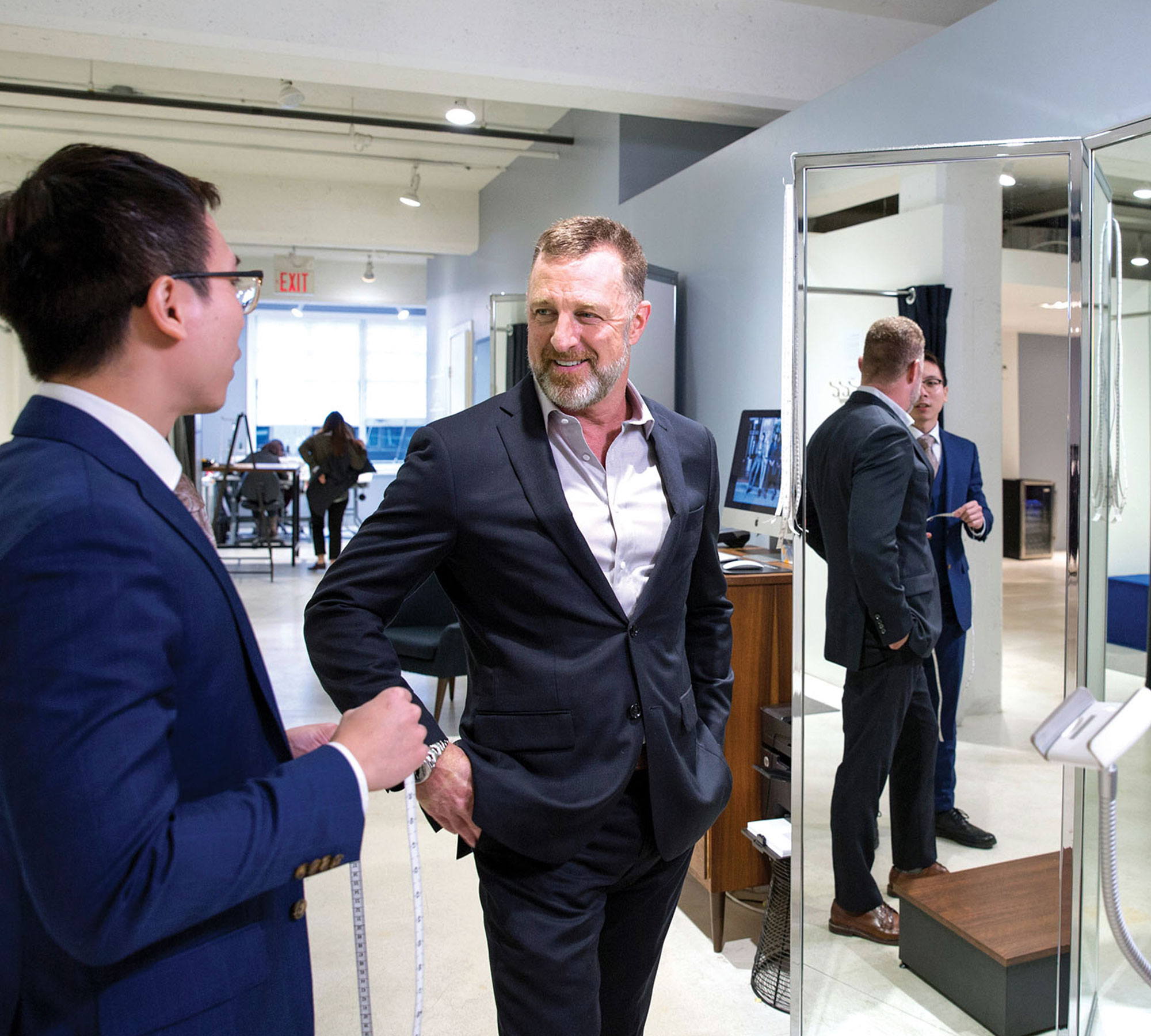The direct-to-consumer model continues to gain traction, changing the relationship between brands and consumers. Ivey alumni share how they’re improving customer experiences.
One of the biggest business stories of the past decade has been the popularity of the direct-to-consumer (D2C) model of selling products. Companies like Warby Parker, Dollar Shave Club, Casper, and Glossier completely transformed the way we buy items like eyeglasses, razors, mattresses, and makeup. Products in previously staid retail categories that lived in old-school department stores now come straight to your door with a quick click.
The name says it all. D2C is the marketing and selling of products directly to the consumer, without any middleman. The D2C model is unlike wholesale sales, where a brand or manufacturer distributes products to retailers in bulk, and those retailers then sell the products. D2C companies forgo all that, choosing instead to do it all themselves.
Many D2C companies are vertically integrated, meaning they control most, if not all, aspects of the business — from manufacturing to marketing to distribution. Many of these brands are e-commerce natives, and some skip bricks and mortar entirely.
“Going direct allows manufacturers to build better relationships with their end consumer,” says Tanya Mark, HBA ’99, PhD ’08, Associate Professor of Marketing and Consumer Studies at the University of Guelph. “It can reduce costs because you don’t have to pay the retailer for shelf space. You know what’s moving, you have your own data immediately, and you get feedback directly from your customers. It allows you to develop a better experience for the customer.”
This is the perfect time for the D2C model to flourish, Mark says, partly because of a change in consumer behaviour. She notes that in 2000, during the dot-com boom, companies raised millions of dollars with e-commerce models. But a lot of them went bust because consumers “just weren’t ready to trust.”
Now, mobile phone penetration has skyrocketed, and there is a whole new generation of digital natives who are entirely comfortable buying online. As well, things like improved return policies and credit card companies covering fraud have made a big difference, she says.
Mark says that the proliferation of the D2C model has been a “long time coming.” As a population, consumers are more educated and they want value. “We want product that’s going to satisfy our needs, but also we want to get it for the best price.”
A Daily Dose of Luxury

“We own all components of our business. It gives us not only the ability to speak to our customers and really hear what they’re saying, but also gives us control over the customer experience.” —Katie Sellers, HBA ’12, Director of Finance at Mejuri
There’s a preconceived notion of how fine jewelry is sold — secured behind glass at fancy boutiques, with snooty salespeople and typically male customers.
Mejuri has turned that concept on its ear. The Toronto-based fine jewelry brand was founded in 2015, and was created with the idea that fine jewelry should be accessible to everyone in their everyday lives, says Katie Sellers, HBA ’12, Director of Finance at Mejuri.
“It’s taking a purchasing category that had a lot of connotations and removing those barriers to empower the end consumer — a woman who’s going to buy it for herself and embrace the daily dose of luxury,” she says.
Like many D2C brands, Mejuri is able to offer lower prices because it eliminates the middleman, or in this case, a few middlemen. The company designs everything in-house, then works directly with manufacturers both in Toronto and abroad to produce in small batches. They have brick-and-mortar stores in Toronto, San Francisco, New York, and Los Angeles — with more on the way — but sell primarily through their e-commerce platform.
“If you look at Mejuri versus a traditional retailer for fine jewelry, we’ve essentially restructured the entire retail process,” Sellers says. “We own all components of our business. It gives us not only the ability to speak to our customers and really hear what they’re saying, but also gives us control over the customer experience.”
Mejuri reaches their target demographic, millennials aged 25 to 35, through their own social media channels, as well as enlisting influencers and micro-influencers to help spread the word about the brand.
One of Mejuri’s signature marketing moves is the Monday drop, where they release and promote a new item every single week. It’s a concept that would be unheard of in traditional jewelry retail, Sellers says.
“The Monday drop model allows us to constantly learn from our customers, see what they like, and ensure that we are actually developing things that they want to wear,” she says.
Sellers says that it isn’t always easy being so disruptive in a very old and traditional industry. “That’s the challenge — truly making a change in the way that the industry operates.”
Made-to-Measure for Less

“The challenge is to get people thinking that we are much more than a suit company without losing our roots and our core DNA in suiting itself. That certainly is on our strategic front burner.” —Peter Housley, HBA ’84, Chief Revenue Officer at Indochino
Disruption is also the name of the game, says Peter Housley, HBA ’84, Chief Revenue Officer at Indochino.
The Vancouver-based company was inspired by markets in the Asia-Pacific region where you can buy a made-to-measure suit from a local tailor at a low cost. With Indochino, customers can do the whole process electronically, selecting their desired style and fabric online, sending in their measurements, and then receiving a custom suit to their door within a few weeks.
Housley says they can fill an order for a made-to-measure suit in seven-to-10 days for $399 USD. Millennials are their “bulls-eye” customer because they are “over-indexed in online purchases and they have a high propensity for custom everything.” But they have a secondary target group they call the “executives,” men over 40 who work in finance.
While Indochino is disrupting an old-school industry, they see the value in bricks and mortar as a core component to their business. Starting as a fun way to promote the brand, the company introduced pop-up shops with “travelling tailors” in places like Grand Central Station in New York City. “We would put a million dollars through a pop-up shop in 10 or 12 days,” Housley says.
Realizing that customers liked to touch the fabrics and see the suits in person, Indochino began launching showrooms in places like Vancouver, Toronto, New York, and San Francisco. Now, they have more than 50 showrooms across North America. Housley says that what makes their showrooms different from regular retail is that they don’t carry any inventory, which makes them very efficient to run.
Indochino recently added coats and casualwear to its range, Housley says. Now, the challenge is figuring out how big the addressable market is for suits, and at what point they should step up to being an apparel company.
“The challenge is to get people thinking that we are much more than a suit company without losing our roots and our core DNA in suiting itself,” Housley says. “That certainly is on our strategic front burner.”
Helping D2C Brands with Data and Insights
At Farfetch, customers can find a sequined party dress, a timeless cashmere sweater, or an “it” bag, and they don’t have to step into a high-priced department store to do it.
“Our vision is to be the global platform for luxury goods,” says Meilene Lam, HBA ’11, MSc ’12, Head of Trading at London, U .K.-based Farfetch.
Lam says that originally Farfetch was a platform for smaller luxury boutiques to sell online, for “mom-and-pop” shops hoping to open up their stores to global traffic, and for people interested in luxury fashion. But as their audience has grown, they’ve attracted major brands like Gucci, Burberry, Valentino, and Saint Laurent who have seen the advantages of reaching customers directly through their popular e-commerce platform.
While Farfetch isn’t a D2C brand itself, many D2C brands choose to sell on their platform, she says.
“Farfetch unlocks a huge captive audience of high-net-worth shoppers. And that’s all part of making sure that you’ve got the right suppliers on the platform who are uploading stock that’s interesting for the customer.”
Lam says brands are also interested in the rich reservoir of data and analytics that Farfetch has amassed. “It helps them understand buying patterns, pricing changes, promotional behaviours, and gaps in the market.”
In addition to informing the companies that sell on their site, Lam says the vast amounts of insights they have on luxury customers is also helping inform Farfetch’s next venture, which is to make clothes themselves.
Farfetch recently acquired New Guards Group, an Italian luxury fashion production and distribution holding company that includes hot fashion lines like Off-White and Heron Preston. The plan is for Farfetch to leverage their data to launch their own products and brands.
“The idea is trying to tap into the customers’ buying histories and feed that into the design process, so we can start to lead the market,” Lam says. “Producing our own goods that are in line with customer trends.”
From D2C to Omnichannel

“At the end of the day, you want all customers to have a unified experience with the brand. What the tree registry program allows for is, no matter where you buy our products, you come back online and understand the impact of your purchase, hopefully resulting in a lifelong customer.” —Derrick Emsley, HBA ’12, CEO at tentree
As a socially conscious organization in an era when so many companies have entered the space, it can be challenging to “cut through the noise,” says Derrick Emsley, HBA ’12, CEO at tentree.
Emsley and his brother Kalen Emsley, HBA ’11, co-founded the company with David Luba in Regina, Sask. in 2012, with a very simple concept. They would plant 10 trees for every item of clothing they sold. Now, 35-million planted trees in, they’ve set their sights on planting one-billion trees by 2030.
“Every single product we’ve created, we try to tie back to the tree planting in a really meaningful way,” Emsley says. Each tentree product, which includes hoodies, t-shirts, and outerwear for men and women, comes with a token that has a unique laser-etched code. By entering that code into the tentree site, customers can find out where their trees are planted and what the benefits are.
While D2C is an important channel for tentree, Emsley says they’ve also developed partnerships with like-minded retailers who carry their products, like Mountain Equipment Co-op and Sporting Life. It’s a way to spread their message, and they are able to maintain their direct relationship with customers because every product is connected back to the impact through the tree code.
“At the end of the day, you want all customers to have a unified experience with the brand. What the tree registry program allows for is, no matter where you buy our products, you come back online and understand the impact of your purchase, hopefully resulting in a lifelong customer,” Emsley says.
One of the priorities with the D2C side of their business is being able to own their narrative, he says.
“We can’t count on others to tell that story for us. But at the same time, if we’re partnered with really good people, they will help amplify it,” he notes.
A Monolithic Brand Goes Direct
While there are many examples of disruptive companies that originated and thrived as D2C brands, some of the biggest companies in the world are getting in on the D2C model. That move usually goes hand-in-hand with e-commerce, as is the case with Nike Direct.
Nike has a long history of selling wholesale through retail partners, but they formed Nike Direct “to get better at being a retailer,” says Joseph Ho, EMBA ’02, Senior Manager, Nike Direct in Greater China. Ho’s division is comprised of both online Nike stores and Nike factory stores, he says, but now that e-commerce has taken off, it’s a growth engine for Nike.
The D2C experience is very tied to the Nike app, which was created to make it “easy for customers to find Nike products and services,” Ho says. The app includes a membership with a rewards program that they customize for each consumer based on their past shopping history.
“For example, we see that you’re a big basketball fan because you shop for basketball shoes. Well, here’s a ticket to the NBA finals to see the Toronto Raptors, just to thank you,” Ho says. “We realized that a lot of consumers are very passionate about Nike, so how do we create an even stronger relationship with them?”
The company has recently launched Nike Fit, which allows customers to scan their feet using their mobile phone. Once the app has their specific foot measurements, it will only recommend shoes in their particular size.
Ho notes that in his experience, Nike consumers don’t care about online versus offline — “They look at it as one company,” he says.
In addition to investing in the online side of the business, Nike has made big investments in bricks and mortar, launching two massive flagship stores — one in Shanghai and one in New York City. These “Houses of Innovation” are packed with fun, tech-forward features. “Within the community it’s become a must-visit destination when people come to Shanghai,” he says.
It’s all in the service of building deeper relationships with customers, Ho says, a necessity in the world of D2C.
“Companies that understand their customers and build community will be successful,” he says. “It’s a cool space to be in because things are changing so fast.”
Photos: Nation Wong (Katie), Matthew Sherwood (Peter and Derrick)
Art Direction: Greg Salmela, Aegis



